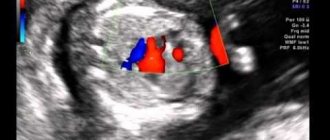| For a pregnant woman, the heartbeat of her unborn baby is a very important indicator and moral support. This knock can indicate whether the child is healthy or not. Of course, the mother will not understand this on her own, but doctors will identify pathologies if they are present. |
- Timing of detection of fetal heart rate
- Causes of fetal heart rhythm disturbances
- Why is the fetal heartbeat determined?
- Methods for listening to the fetal heartbeat
- Determining the sex of the baby by heartbeat
- How can you hear your child’s heartbeat?
When can you hear the fetal heart?
The question of when a fetal heartbeat appears is relevant for every expectant mother, as is such an important point as fetal movement during pregnancy, the norm of which may be different for each woman. The heartbeat can also be heard for the first time at different times.
Women who are interested in how long the heartbeat appears should understand that the fetal heart does not start beating at once. When the formation of this organ begins, part of the tissue that will subsequently develop into the ventricles of the heart performs contractile movements. Of course, the period when the fetal heartbeat is heard on an ultrasound comes later.
The gynecologist will tell you at what week this sound is heard: it can sometimes be heard already in the very early stages. At what hCG level a heartbeat is heard and at what time it is “visible” on an ultrasound also depends on the power of the device used to conduct the study. Using a regular abdominal ultrasound probe, the doctor can hear heartbeats as early as 5 weeks. And with the help of a vaginal sensor, beats can be heard already at 3-4 weeks, that is, immediately after the fetal heart begins to beat.
The heart rate depends on what week the heart beats. It is different at different stages of pregnancy.
- When the period is 6 weeks - 8 weeks, the fetal heart rate is 110-130 beats per minute.
- In the period from 8 to 11 weeks - heart rate can increase to 190 beats.
- Already from 11 weeks the frequency is 140-160 beats.
The table below shows the heart rate at different stages of gestation. It is very easy to understand how many beats per minute the baby’s heart should beat during different periods of pregnancy.
Fetal heart rate table by week:
| Term | Beats per minute |
| 4-6 weeks | 80-85 |
| 6 weeks | 100-130 |
| 7 weeks | 130-150 |
| 8 weeks | 150-170 |
| 9 weeks | 170-190 |
| 10 weeks | 170-190 |
| 11 weeks | 140-160 |
| 12-40 weeks | 140-160 |
Those who are interested in the table of fetal heart rate by week by gender of the child should know that both girls and boys have the same heartbeat.
The doctor evaluates not only the fetal heartbeat by week, but also additional factors, such as the child’s activity phase, diseases of the mother and fetus, the time when the frequency is determined, etc.
If the normal fetal heartbeat is disrupted over the weeks, this may be due to various reasons.
What do you pay attention to when listening?
The formation of the heart in the fetus begins one of the first, and its work is the most important indicator of the development of the unborn baby and its general condition. Listening is carried out throughout pregnancy and during childbirth. It is thanks to monitoring the heartbeat that pathologies of the unborn child are detected at an early stage.
Development of the heart in the embryo
The myocardium begins to contract around the third week, but the heartbeat appears no earlier than the fifth or sixth week, and is determined only by ultrasound. At the same time, the heart begins to transform from a hollow tube into a full-fledged organ consisting of four chambers - two ventricles and two atria. At 5 weeks, you can only listen to the heart using a transvaginal sensor; this can be done using the transabdominal method no earlier than 6-7 weeks.
When listening, pay attention to the following indicators:
- Heart rate is the frequency of heart contractions. A heartbeat that is too fast (up to 200 beats per minute or more) is called tachycardia, and a heartbeat that is too rare (less than 100) is called bradycardia. Both conditions are considered pathological and require examination, diagnosis and medical care.
- Character of tones. In a healthy heart, the beats are clear and sonorous; with the development of pathology, they become dull and blurred.
- Rhythm. Under normal conditions, the heart beats repeat at regular intervals. With acute and chronic hypoxia (lack of oxygen), as well as with valve defects, arrhythmia is observed.
Video about the possibilities of ultrasound in early pregnancy, including heartbeat examination:
Why is the heart rhythm abnormal?
If heart rate is less than 120 beats per minute
- The causes of a weak heartbeat in the early stages may be due to various reasons. It can be fixed for a short period of time - up to 4 weeks. At week 6, the embryo's pulse can be 100-120 beats. A pulse of 130 beats also indicates that everything is fine with the baby. But if a very low heart rate is recorded, less than 80 beats, then there is a risk of pregnancy loss.
- If an ultrasound at 12 weeks or more indicates a low heart rate, this may be due to chronic hypoxia of the fetus or its reaction to the umbilical cord being compressed. If the heartbeat is 120 beats per minute, the doctor should tell you what to do, based on the research results.
- Before birth, a weak rhythm may be evidence of acute or chronic fetal hypoxia, as well as compression of the umbilical cord during contractions.
If your heart rate exceeds 160 beats per minute
- In the first weeks of pregnancy, this is usually normal, but in some cases it indicates a placentation disorder.
- After 12 weeks of pregnancy, the fetus may react in this way to its own movements or to the stress experienced by the mother.
- tachycardia in later stages may be a consequence of chronic fetal hypoxia or a reaction to movement or contraction.
Sounds are dull, tones are hard to hear
- If listening is carried out in pregnant women in the early stages, this may indicate that the period is too short, or the study is carried out with a faulty sensor, or the listening device is outdated. This is also possible if the mother is obese . But also hard-to-hear tones in the early stages may be evidence that the baby has a heart or vascular defect.
- After 12 weeks, dull tones can be heard if the mother is obese, as well as with feto-placental insufficiency , presentation (if the placenta is located on the anterior wall), oligohydramnios or polyhydramnios. Sometimes dull tones are recorded if the position of the baby in the womb is inconvenient for listening. However, heart or vascular defects are also possible.
- In late tones, this phenomenon indicates that active contractions have begun or fetal hypoxia .
No heartbeat
- At the earliest stages, the sound of a heartbeat is absent if the period during listening is very short, or an outdated sensor is used. However, sometimes this is evidence that the pregnancy has stopped or an abortion .
- At a period of 12 weeks or more, as well as in the last weeks, the absence of a heart sound can either be evidence of an incorrect site of auscultation or a breakdown of the CTG sensor, or indicate that antenatal fetal death .
Prevention and treatment of fetal bradycardia
Women with chronic diseases of the cardiovascular, endocrine, digestive systems, obesity, and mental disorders are prone to bradycardia. Risk factors also include:
- Constant emotional stress - for example, due to stressful work, an unhealthy family environment (including physical and sexual abuse);
- Physical discomfort - in particular, regular heavy lifting, playing sports, working or living in a highly toxic environment, eating disorders;
Treatment of this disease depends on its intensity, the risk to the health of the mother and fetus, and the causes of its occurrence. The main goal of therapy is to eliminate the provoking factor, reducing the danger for the woman and the unborn child:
- For mild bradycardia, the doctor prescribes preventive measures - walks in the fresh air, low-intensity physical exercise, taking mineral and vitamin complexes, dietary nutrition, etc. In this case, the expectant mother does not remain in hospital for treatment, but only undergoes regular examinations.
- Severe bradycardia can lead to pregnancy loss, so the patient is admitted to a hospital inpatient care. The doctor prescribes treatment for the underlying maternal disease causing the pathology, and at the same time stimulates placental blood flow to reduce or eliminate fetal hypoxia. However, even if these problems are resolved, the woman remains under observation until the end of the pregnancy. Usually in such cases a caesarean section is prescribed, since the child may simply not survive a natural birth.
Early detection of fetal bradycardia is the key to successful treatment of this disease. Therefore, all pregnant women, even if they are not at risk and do not have visible symptoms of pathology, are recommended to regularly visit an obstetrician-gynecologist and undergo medical examinations.
Why determine the fetal heartbeat?
The presence of a heartbeat and the rate of fetal heartbeat are determined during pregnancy for a specific purpose.
To determine that pregnancy is progressing
After the expectant mother takes a pregnancy test and it comes back positive, the woman goes to the hospital to have an ultrasound scan. Modern ultrasound machines make it possible to hear the heartbeat of the embryo already during the first examination - at 4-5 weeks. But if you can’t hear the baby’s heart at the first ultrasound, you shouldn’t panic. As a rule, when the procedure is repeated, you can hear the expected sound. However, sometimes a heartbeat does not appear, and the fertilized egg becomes deformed. This condition is defined as frozen pregnancy . In such a situation, medical termination of pregnancy is performed using special drugs. If such a situation occurs, then the woman is not recommended to become pregnant for about six months after this.
To assess fetal development
There are clear indicators of what is considered normal heartbeat at what stage. That is, a normal heartbeat per minute is determined depending on the period of development of the baby. The embryo's heart reacts to any changes in the world that surrounds it. After all, stress or illness of the mother directly affects children. Also, the rate of heart beats per minute varies depending on the period of activity or sleep of the fetus. The level of oxygen in the air also affects the heart rate. However, any disturbances associated with exposure to such factors are temporary.
If the heart rate is too high for a long time, the doctor may suspect problems with the blood supply to the fetus, so-called fetoplacental insufficiency . As a rule, this condition is chronic. Sometimes, when the child's compensatory capabilities are depleted, the heart rate is too slow. This indicates that the condition of the fetus has worsened. In such a situation, a decision is sometimes made to perform an emergency delivery. The doctor takes into account what the heartbeat should be in which week, and when exactly the pathology appeared, determines the treatment tactics.
Determination of fetal condition during labor
During childbirth, the baby experiences very strong stress, lack of oxygen and compression. If everything goes well, then his heart and blood vessels cope normally with such loads. However, sometimes emergency conditions occur, for example, placental abruption , umbilical cord clamping , in which prompt medical attention is needed. That is why during childbirth the doctor determines how many beats the heart rate is after each contraction, so as not to miss the development of an acute lack of oxygen.
How the heart develops
The rudiment of the organ is formed in the 4th week, and by the 5th week pulsating contractions first appear and autonomous blood circulation appears. While the blood circulates in one stream, representing one tube, in the bend of which there is a small motor - the fetal heart. By the ninth week of pregnancy, the small heart becomes four-chambered. It differs from the organ of an adult, but is still fully formed. These weeks are the most important stage when any disruptions in the formation of an organ lead to congenital defects.
What methods are used to determine heart rate?
Ultrasonography
The first method to determine whether the heart rate is normal or not is an ultrasound examination. During an ultrasound, together with an assessment of the heartbeat, the doctor assesses the condition of the placenta and the size of the fetus.
The sounds of the heart are listened to very carefully, and its structure is studied if the woman has already given birth to children with vascular and heart defects. If the mother suffered infectious diseases during pregnancy, special attention is paid to the work and structure of the heart.
If necessary, an ultrasound of the fetal heart is performed during pregnancy. At what time to do an ultrasound of the fetal heart is determined by the doctor. The most optimal time to study echo CG is 12 weeks. But a woman can conduct an echocardiography at her own request to make sure that everything is fine with the child.
Auscultation
This method involves listening to heart sounds using a special obstetric stethoscope. True, the answer to the question of whether it is possible to hear a heartbeat in the early stages with a stethoscope is negative. The period when you can hear with a stethoscope is 18-20 weeks. An experienced doctor can determine a number of indicators using such a device. He will listen to the approximate rate at which the heart beats, determine the clarity of the tones and find the place where they are heard best. The algorithm for listening to the fetal heartbeat and determining heart rate is simple: this can be done using a stopwatch.
But sometimes auscultation with a stethoscope is difficult or even impossible. This is likely if the mother is very heavy, if the placenta is located on the anterior wall of the uterus (in this case, the noise of the vessels interferes), if there is very little or a lot of amniotic fluid.
Cardiotocography (CTG)
This is an informative method with which you can evaluate the fetal heartbeat. This procedure makes it possible to determine the oxygen starvation of the fetus in the early stages and promptly eliminate this problem.
A CTG machine is an ultrasound sensor that sends and receives reflected signals from the heart. In this case, all rhythm changes are recorded on tape. During the procedure, the doctor installs not only the main sensor, but also a uterine contraction sensor, with which you can determine the activity of the uterus. The most modern devices have fetal movement sensors, and sometimes there is a special button so that the woman herself can record the movements.
The entire process of CTG examination takes about 60 minutes. During this period, in most cases, it is possible to record the period of sleep and activity of the fetus. But sometimes there is a need to examine the condition of the fetus throughout the day. Then the sensors attached to the stomach are left for a day.
Heart rate analysis is carried out taking into account the stage of pregnancy at which the study was carried out. The first CTG is performed at 32 weeks. If it is carried out earlier, at 30 weeks or even earlier, the results will be uninformative. When the 31st week passes, a relationship is formed between cardiac activity and fetal motor activity.
Most often, a pregnant woman undergoes this test twice – at 32 weeks and before giving birth. This procedure does not harm either the woman or the baby, so it can be performed as many times as necessary.
A specialist deciphers the CTG tape and compares the results with test and ultrasound data. However, cardiotocography is not a source of definitive diagnosis.
What is a “good” CTG
“Good” CHT is considered if the indicators are as follows:
- Normal heart rate is from 120 to 160 beats per minute;
- when the baby moves, the heart rate increases;
- There is no decrease in heart rate or it is observed very rarely and in small quantities.
The device analyzes these indicators and, based on its results, issues a special PSP index. If the condition of the fetus is normal, then this index is not more than one.
However, it must be taken into account that a variety of factors influence how a child’s heart works. And only a specialist can evaluate them correctly.
Why is a “bad” CTG determined?
- Most often, changes on CTG are determined if fetal hypoxia . An increase in heart rate is characteristic of a condition when the fetus does not have enough oxygen, and the heart is forced to work very intensely.
- When a contraction or movement occurs, the baby's heart rate may slow down, which is not normal.
- Short changes on the tape are recorded if the umbilical cord is pressed against the fetal head. In this case, the results look the same as with oxygen starvation, but the baby feels normal.
- If the sensors were not attached correctly, the results obtained may also be “bad”.
If hypoxia by listening to the fetal heartbeat, the doctor conducts additional studies to confirm or refute the diagnosis. If hypoxia is confirmed, treatment is carried out, or the doctor decides on emergency delivery.
Echocardiography
Echocardiography is used if there is a suspicion of heart defects in the fetus at 18-28 weeks of pregnancy. Using this method, you can determine the structural features of the heart and blood flow. This procedure is carried out in the following cases:
- the expectant mother already has children diagnosed with heart defects;
- infectious diseases were suffered during pregnancy, especially in the first weeks;
- the mother has congenital heart defects;
- the expectant mother is over 38 years old;
- The woman has been diagnosed with diabetes mellitus ;
- intrauterine growth retardation is noted;
- the fetus has malformations in other organs, and there is a possibility of developing congenital heart defects.
This method is used both as a two-dimensional ultrasound and using other modes of an ultrasound scanner: Doppler mode, one-dimensional ultrasound. With this combination of techniques, it becomes possible to carefully study the structure of the heart and the features of blood flow.
Auscultation
This is a physical diagnostic method that has been used for many years. This means listening to the fetal heartbeat. A stethoscope is used to perform auscultation. The instrument is applied to the belly of a pregnant woman lying on the couch.
Heartbeat is detected starting at 20 weeks. As the fetus grows, heart rhythms become clearer. During the examination, the specialist finds the point of best listening to tones. It determines the rhythm and nature of heart contractions. If the tones are clear and clean, everything is fine. Deafness of tones indicates the presence of intrauterine hypoxia.
Auscultation is a simple and accessible method. This is an advantage due to which this method of listening to the fetal heartbeat is used to this day. But it also has a significant drawback: difficulty in localizing sounds.
Is it possible to determine the sex of a child by heartbeat?
Many women at a certain period of pregnancy are actively worried about how to determine the sex of the child by the fetal heartbeat. Indeed, among pregnant women and even among some medical workers, “there is a legend” that such a determination is possible, as well as the assumption that the size of the fetus can help determine who will be born - a boy or a girl.
It is believed that girls' hearts beat faster, and at 13 weeks or later their heart rate is up to 160 times per minute. According to this “belief,” boys’ heartbeat is 135-150 beats. But those who actively ask doctors questions: “How to find out the gender of a child by heartbeat at 12 weeks” or “At what age is this possible”, you need to take into account that this method is not scientifically based. Although there is an opinion that this method is only relevant up to 20 weeks.
The question of how many weeks it is possible to determine the sex of a child in this way is not relevant in principle, and heart rate is not a determining indicator. After all, it is possible to determine whether a boy or a girl is a boy or a girl by frequency only with an accuracy of 50%.
True, there is an opinion that in this case the fetal heartbeat is also important. Some “experts” claim that in boys it is more rhythmic, and in girls it is more chaotic.
There is one more sign: in boys, the heart rhythm coincides with the rhythm of their mother, but in girls it does not. But all these methods have nothing to do with medicine. After all, heart rate reflects the fetus’s ability to overcome a lack of oxygen, and not gender. Therefore, for mothers who begin to “guess” the gender immediately when the embryo’s heart begins to beat, it is better to get a high-quality ultrasound from a good specialist who will help find out the baby’s gender with high accuracy.
Who will be born: modern ways to find out
There are 2 reliable ways to find out who will be born in a family.
The first is ultrasound. Already at the second screening, that is, from the 12th week, you can get an answer. But errors are also possible - the method guarantees the correct result in 97% of cases.
The second method is amniocentesis. This invasive technique is carried out according to strict indications and not to find out who will be born to a couple, but to diagnose certain diseases in the baby. And sex determination is only an additional option of amniocentesis. But this is currently the only method that gives a 100% correct result.
Is it possible to hear a baby's heartbeat at home?
Is it possible to hear heartbeats with a phonendoscope? Those who are interested in how to listen to the heartbeat at home can use several methods. You can hear this sound, pleasant for parents, at home using a stethoscope, a portable device - a fetal doppler, and, finally, simply by placing your ear to your tummy.
How to listen to the heartbeat at home will be discussed below. After all, there is no need to visit a antenatal clinic for this. If the expectant mother and her entourage have experience, the heart can be heard earlier. After all, a more experienced woman notices fetal movement earlier during her second pregnancy. The normal heart rate, however, must be monitored by a doctor.
Using a stethoscope
You can listen to the heart using an ordinary obstetric stethoscope. It is necessary to purchase an obstetric tube and use someone's help. Of course, it will not be possible to listen to a fetus at 12 weeks of pregnancy at home. If this person does not have experience, then it will not be possible to hear anything earlier than 25 weeks. But if the fetus is listened to at 30 weeks, then it is much easier to hear the beats. You just need to practice a little and get the hang of it. In this case, it is necessary to clearly distinguish what it is - the pulse, the peristalsis of the pregnant woman, the movements of the fetus, or its heartbeat.
Using fetal doppler
If you wish, you can buy a special device - a fetal doppler. This is a portable ultrasound detector that works like a regular CTG machine, but the image is not captured on film. Sometimes headphones are included so you can hear sounds clearly. With the help of Doppler, you can hear heart sounds starting at 8 weeks. However, it is better to start using this device a little later. It is important that the study itself does not last longer than ten minutes.
The advantages of this device include the ability to listen to the heartbeat in the early stages, as well as ease of use and the ability of a woman to do this without help.
The disadvantages of using Doppler are its high cost and limitations in use. In addition, this device should not be used without measure.
Putting your ear to your stomach
Sometimes you can hear the heart just by putting your ear to your tummy. This is possible in the last weeks of gestation. However, a positive result can only be obtained if the expectant mother does not have too much fat.
You need to listen to the heart in a certain place in the abdomen, depending on how the baby is positioned. If it lies head down, then you need to listen to the heartbeat below the woman’s navel. If the baby's head is at the top, then it is advisable to listen to the tones above the mother's navel. During multiple pregnancies, the heartbeat of each fetus can be heard in different places.
Is it possible to listen to the fetal heart yourself?
Many mothers are interested in how many weeks the unborn baby’s heartbeats can be heard. It is difficult to listen to its beats at home, especially at the beginning of pregnancy. You shouldn't start using a stethoscope before 25 weeks. You can hear the baby’s heart by placing your ear on your stomach from the 30th week. At an early stage (from about 8 to 12 weeks), this is done using a modern device - a fetal doppler. The device is very easy to use, it can be used without assistants. In addition, it records the heartbeat and is given to relatives to listen to.
Video lecture on fetal CTG (heartbeat study):
conclusions
Thus, heart rate is a very important indicator of child development. The pulse rate is monitored by a doctor during pregnancy. Expectant mothers should know that severe heart pathologies are very rare, and in most cases, babies are born healthy. But, nevertheless, it is important to regularly undergo all tests and monitor your heartbeat. The rate of beats per minute in women and children are important indicators, and the doctor takes this into account. But the expectant mother herself should be very careful about her own health and “listen” to the baby.
Electronic fetal monitoring
This is an advanced technique with which serious complications are determined: cerebral palsy, intrauterine death, cardiac dysfunction. Fetal monitoring is carried out as follows: the woman in labor, lying on her back, has belts with sensors placed on her stomach. One device records the fetal heartbeat, and the second - the duration and intensity of uterine contractions. Sensors are connected to the monitor.
In some cases (for example, serious danger to the fetus), an internal examination is used. Its essence is as follows: the electrode is inserted through the cervix and placed on the baby’s head. With such an examination, the doctor receives the exact data necessary to assess the current situation. Internal monitoring is used after rupture of membranes. The cervix should also be dilated (at least 1 cm).
External electronic monitoring lasts about half an hour. Innovative devices are used in clinics. For example, these could be Avalon fetal monitors. This is technological equipment with the best characteristics. It is distinguished by functionality, long service life, and ease of use.
Fetal monitoring is an advanced technology used in medical institutions equipped with the latest technology. Therefore, we need to take a closer look at its features and advantages.
The process of formation of the cardiovascular system of the embryo
Fetal CTG is normal. Fetal CTG is normal at 36 weeks. how to decipher fetal CTG
The rudiments of the cardiovascular system (like many others) are formed already at 3-4 weeks. At this moment, the baby develops the largest blood vessels and even the heart, which is an unfragmented lump of tissue.
The heart rudiment is located exactly in the center of the embryo and already has an arterial trunk, a venous sinus, an atrium and a ventricle (they are still common, but will later divide).
Week 5 is characterized by the transformation of a tissue clot into a two-chamber heart, and then into a three-chamber one; The first contractions of the small heart occur. At this stage, the baby’s first heartbeat begins to be heard, which can already be detected by ultrasound machines.
It is important to note that even at such a short time during the examination, the rudiments and process of heart formation are visible. Thus, the first trimester is the period when the heart of the unborn child is formed
When and how to measure CTG during childbirth
The CTG device has two sensors. One of them is attached in the place where the doctor can best hear the baby’s heartbeat, he records the baby’s heartbeat; the other is in the navel area, approximately where the fundus of the uterus is located, it registers contractions. Sometimes the device has an additional manual recorder - the mother presses a button if she feels the baby’s movements, because at the same time the baby’s pulse also quickens.
In a healthy pregnant woman during normal labor, the CTG device is used three times: upon admission (at the beginning of labor), at the time of discharge of amniotic fluid and at the beginning of pushing. If labor is delayed, readings are taken every three hours. They are recorded for 20 minutes, sometimes a little longer.
To take readings, the pregnant woman is usually asked to lie on her left side, but it can also be taken when the expectant mother lies on her back if the position on her side is very uncomfortable for her. But it should be taken into account that when the mother lies on her back, the heavy uterus puts pressure on the inferior vena cava, and the baby’s blood supply may be affected.
If the pregnancy proceeded with complications - chronic fetal hypoxia was diagnosed or any malformations were identified, if a woman gives birth after a cesarean section, if she has gestosis, in a word, if the doctor has reason to believe that complications may arise during childbirth - CTG readings are taken more often, up to a continuous recording of the child’s heartbeat. It is not interrupted even during pushing - a heartbeat sensor is attached to the baby's un-erupted head, and there is no need for a contraction sensor.
CTG is taken more often if epidural anesthesia is used during contractions or labor is stimulated with medication.
Some stages of embryo development
Intrauterine (embryonic) development of a person lasts an average of 265-270 days. During this period, more than 200 million cells are formed from the original cell. In this case, the embryo increases from microscopic size to half a meter.
The development of the human embryo can generally be divided into three stages:
- the period from the moment of fertilization of the egg until the moment the developing embryo is implanted into the uterine wall and begins to receive nutrition from the mother;
- formation of main organs; the embryo acquires the features of a human body (fetus);
- The specialization of the organs and systems of the fetus is completed, and it acquires the ability of independent existence.
Let's look at the individual stages of embryo development:
First of all, when does the embryo implant in the uterine cavity?
It has been established that 6-7 days after fertilization are the time when the embryo attaches to the uterine mucosa (implantation process). During implantation, the embryo is completely immersed in the tissue of the uterine mucosa. The process when the embryo attaches to the wall of the uterus lasts an average of 48 hours.
There are 2 stages of implantation: adhesion (adhesion) and penetration (invasion). In stage 1, the trophoblast attaches to the uterine mucosa and differentiation of two layers occurs in it: cytotrophoblast and plasmodiotrophoblast.
In the second stage, the plasmodiotrophoblast produces proteolytic enzymes that destroy the uterine mucosa. Thus, the trophoblast villi are introduced into the epithelium, and then, successively, into the connective tissue and walls of blood vessels. Trophoblast begins to receive nutrition and oxygen from maternal blood
The period when the embryo attaches to the uterine mucosa is the first critical period of its development, and upon successful completion of this stage, the stage of laying down extra-embryonic organs begins.
When is the embryo visible?
It is generally accepted that the 4th week from the moment of fertilization (at the 6th obstetric week) is the period when the embryo is visible. The body length of a four-week embryo is about 5 mm.
The seventh week from the moment of conception is the period when the embryo is clearly visible: the head, torso and its limbs are clearly visible. Registration and assessment of the condition of the embryo and fetal sac using ultrasound allows you to confirm the presence of pregnancy, determine the location of the embryo in the uterus, and the gestational age.
When does the embryo's heart begin to beat?
There are several answers to the question “when does the embryo’s heart begin to beat”:
- on the twenty-second day (5 weeks) from the moment of fertilization. The circulatory system of the embryo begins its development at 3 weeks of pregnancy. At this time, the wall of the vascular tube in the bend of the loop of the germinal circle of blood circulation makes the first contraction. During the fourth week, the pulsation becomes increasingly stronger and more regular. The pumping of blood through the vessel begins and the fetus transitions to a type of blood circulation independent of the mother - its own type of blood circulation with a single-chamber heart.
- in the sixth week of development. That is, this is the period when the embryo’s heart beats during echoscopy using modern ultrasound machines, and during this period it is already possible to register contractions of the embryo’s heart. By this time, partitions appear in the hollow muscular-connective tissue tube, the heart increases in volume and turns into a two-chamber one. Until the ninth week of embryo development, the formation of heart structures occurs: its atria, ventricles and the valves separating them, inflow and outflow vessels, the conduction system and the formation of feeding blood vessels.
- end of the second month of embryo development. At this stage, the heart of the embryo becomes four-chambered and acquires a structure completely similar to that of a human. The time from the fourth to the eighth week after fertilization is the most dangerous in terms of the possible formation of cardiovascular system defects. The final formation of the fine structures of the heart is almost complete by 22 weeks. In the future, only the accumulation of muscle mass of the heart muscle occurs, and an increase in the supplying vascular network of both the heart itself and other organs of the fetus.










